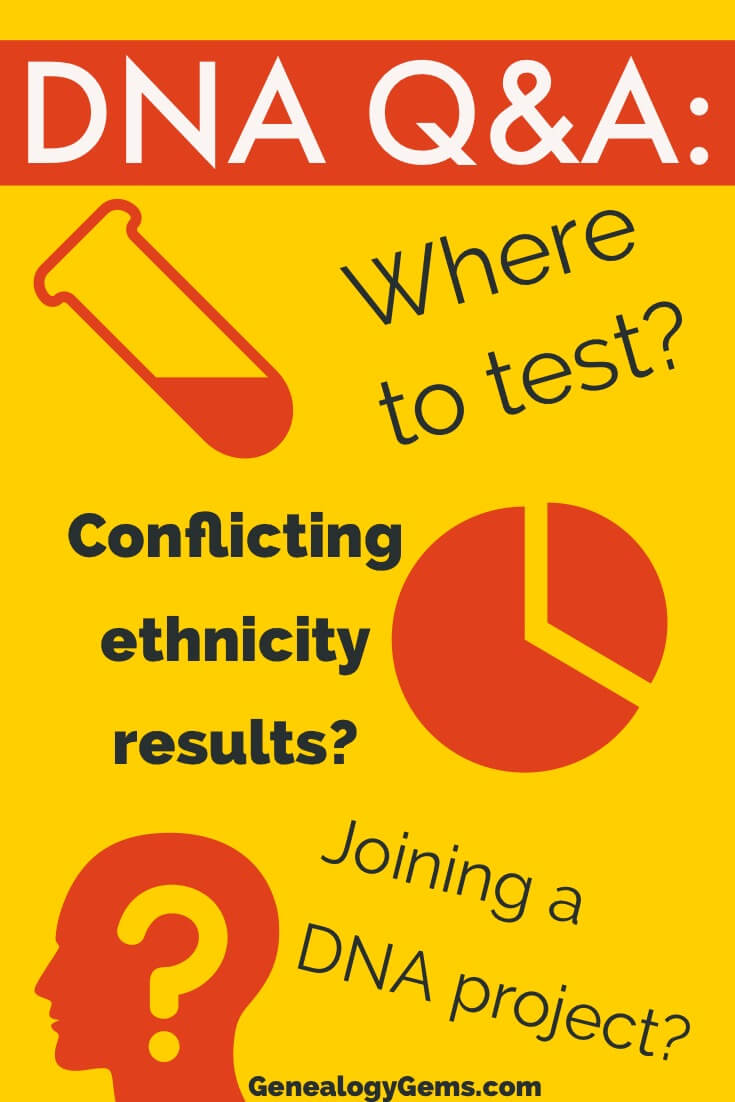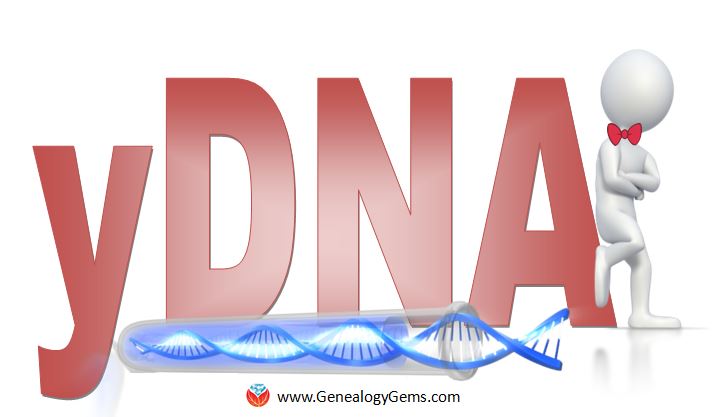by Diahan Southard | Jul 2, 2018 | 01 What's New, DNA, Listeners & Readers
Here’s a YDNA test Q&A with questions from a Genealogy Gems Podcast listener. Your DNA Guide Diahan Southard has answers: where to test, on joining a family DNA project, and those conflicting DNA ethnicity percentages.
Recently Lisa Louise Cooke received a voicemail from Genealogy Gems Podcast listener Ken. He’s been doing genealogy for more than five years and he’s listening to the entire podcast series (he’s up to episode 180 already!). He says, “I’ve made amazing discoveries and listening to you give all of these tips is fantastic! I listen to you on the way to work; I listen on the way home.” (Love it!) Then he asked some DNA questions that Lisa forwarded to me:
“My last name is Maloney. There’s so many of them, it’s crazy. My dad told me that my grandfather got into a fight with his brothers over a piece of land, so they never talked after that. Well, I found out that I have a second cousin with my exact same name who lives three miles from me. I’ve lived here my whole life and I never knew him. I saw him in the phone book, but I never dreamed that he had anything to do with me. I finally met him about two months ago.
Anyway, I want to take the YDNA test and the only one I know about doing it with is Family Tree DNA. Is that a good company to deal with? And, one more real quick thing: AncestryDNA says I’m 69% Great Britain. These other places say I’m like 30-some percent Scandinavian. So who’s right?”
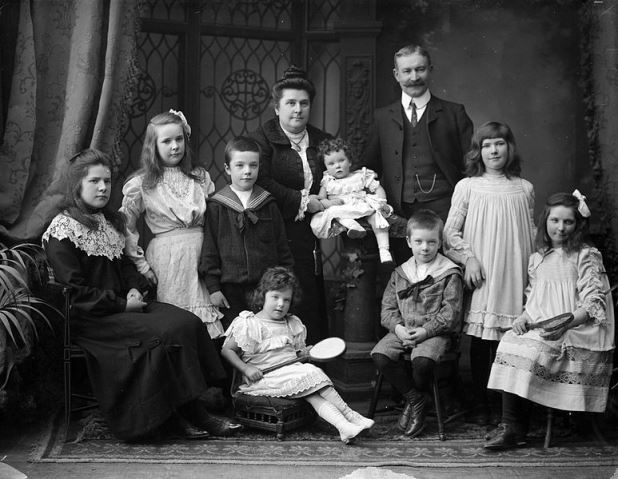
Maloney is a common surname in the United States. In the 2000 census, it ranked #1049 in popularity (click here to see how we know that). There are also a lot of Maloneys in Ireland. This 1906 photo of the Maloney family of Newtown, Waterford, Ireland is at the National Library of Ireland (we found this digitized image at Wikipedia).
On taking YDNA tests
Thanks so much for your question, Ken. I wish everyone had your enthusiasm about YDNA testing! You are absolutely right in thinking that the YDNA test can help you answer questions about your direct paternal line. Because of the way YDNA is inherited, other Maloneys who share your YDNA also share a common ancestor with you.
Yes, the best place to start with YDNA testing is to first test at least 37 markers at Family Tree DNA. 67 is more ideal, but you can always test more later.
Take your YDNA test results a step further
The next thing to do is to join a family project. You can search for family projects right from the homepage at www.ftdna.com. Just put in any surname of interest, and you can see how many people with that surname have been tested, and if there are any family projects associated with that surname. Clicking on the name of a project will take you to that project page where you can join the project and contact the project coordinator with your questions. (Learn more about family or surname projects below.)
Now, while it is of great benefit to see others matching your YDNA and sharing an ancestor with you, an often overlooked benefit of the family project is your ability to see all of the people who are sharing your surname, but do NOT share a direct paternal line with you. This list can be a goldmine, as it can save you hours of wasted research barking up the wrong tree. Any ancestor represented in the surname project who does not share YDNA with you is not your ancestor! It doesn’t matter if their name is spelled just like yours, or that they named all of their eldest sons Solomon, or that they lived in the same county as your family. THEY ARE NOT YOUR FAMILY. So you can move on, and find other, more valuable leads.
DNA ethnicity: Conflicting results
As for your questions about ethnicity, you may want to check out a couple of blog posts here at genealogy gems to point you in the right direction:
Keep up the good genetic genealogy testing, Ken! It is bound to help you and your Maloneys.
More on YDNA tests in Premium eLearning
If you’re a Genealogy Gems Premium eLearning member, you have access to a quick-and-easy video tutorial series on YDNA testing from Diahan Southard (Premium eLearning now has more than 20 DNA video tutorials). You also have access to the recent Genealogy Gems Premium Podcast Episode 160, in which Diahan compares her current ethnicity percentages at major testing sites and gives tips for better understanding them. Click here if you’d like to learn more about Premium eLearning.
About the Author: Diahan Southard has worked with the Sorenson Molecular Genealogy Foundation, and has been in the genetic genealogy industry since it has been an industry. She holds a degree in Microbiology and her creative side helps her break the science up into delicious bite-sized pieces for you. She’s the author of a full series of DNA guides for genealogists.
Disclosure: This article contains affiliate links and Genealogy Gems will be compensated if you make a purchase after clicking on these links (at no additional cost to you). Thank you for supporting Genealogy Gems!
by Lisa Cooke | Jan 28, 2017 | 01 What's New, FamilySearch, Records & databases
Sometimes you find yourself sorting through tons of people with the same last name to see which ones belong on your family tree. This surname research collection at FamilySearch can help you see what other researchers may have spent years compiling about thousands of family groups.
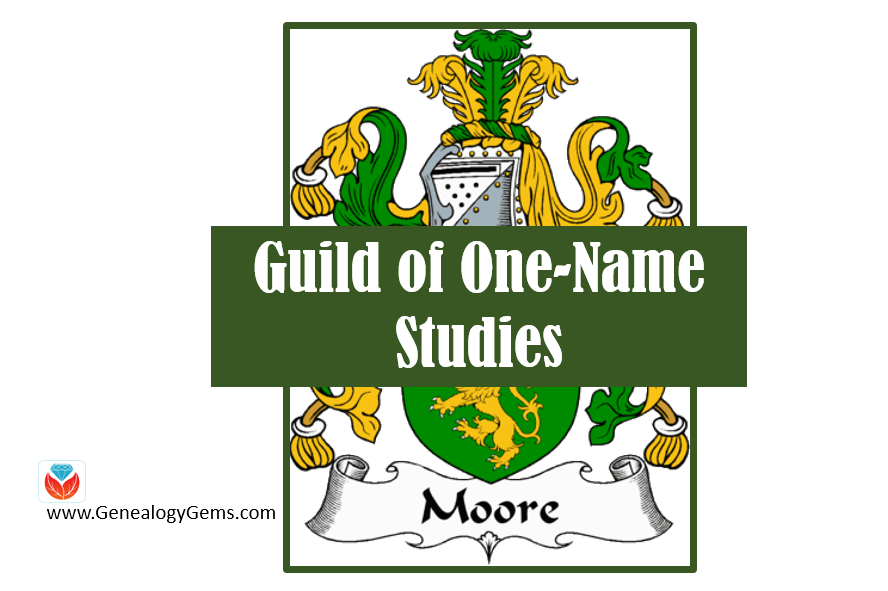
There’s a valuable free but much-overlooked online collection for surname research at FamilySearch.org. These are the family trees of nearly 3000 members of the Guild of One-Name Studies, who are studying nearly 9,000 different surnames. Their resources are strongest for the United Kingdom, where the Guild was founded, but you’ll find members all over the world.
What makes these family trees unique?
There are a couple of things that make these family trees unique:
1. These trees don’t just focus on a mostly-vertical line of ancestors for a single person. Members of the Guild collect everything they can about a particular surname and all its variants (hence the name of the organization). These efforts help organize and connect people with the same surname. Sometimes they help trace the origin of a surname. They can help people explore the variety of spellings and locations associated with different names.
2. These trees are often more fully researched and cited than your average online tree. The Guild takes pride in supporting its members in doing accurate, cited research; keeping their online databases updated; and responding to questions from others about their surname research.
Of course, always use caution when consulting others’ trees. Consider their content to be hints or suggestions until you prove them otherwise yourself. Scrutinize the sources they cite, many of which, say the Guild, aren’t available online elsewhere.
Explore the Guild Surname Research Collections
To explore this helpful free resource, follow the step-by-step instructions below:
1. Go to FamilySearch.org and click Search, then click Genealogies— not Records. (You may also click here to reach that landing page directly.)
2. Enter the surname of interest.
3. Click where it says All next to the Search button.
4. Select Guild of One-Name Studies.
5. Run the search. Click on search results to see:

A. The individual’s name, personal details and (scroll down) associated sources and citation details.
B. The individual’s place in a Guild family tree. Explore this family tree by clicking on someone’s name and seeing their information pop up to the left, where you can also click “View Tree” to see that person’s relatives.
C. Search for names within this tree.
D. This shows you what surname study the information comes from. In this case, you’re also given a link to a separate, associated website for that study.
6. Repeat to learn more about other surnames in your family.
More on Surname Research
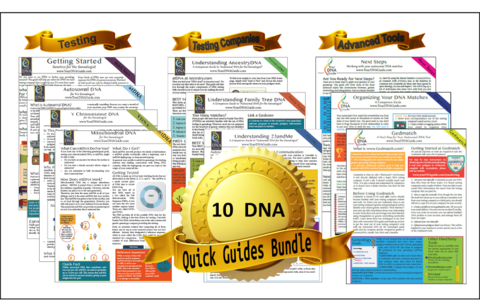 If you are interested in learning even more about surnames research, read Social Network Your yDNA with Surname Projects by our own Diahan Southard, and learn how surname study organizations are taking their research into the 21st century with DNA surname projects.
If you are interested in learning even more about surnames research, read Social Network Your yDNA with Surname Projects by our own Diahan Southard, and learn how surname study organizations are taking their research into the 21st century with DNA surname projects.
Also, learn more about utilizing DNA in your genealogy research with these 10 DNA quick guides from Your DNA Guide, Diahan Southard. They can be purchased in a bundle in either print or digital format.
by Lisa Cooke | Jan 19, 2015 | 01 What's New, DNA, images, Social Media
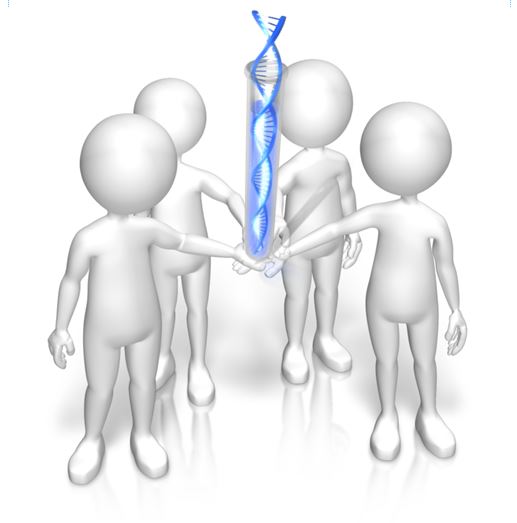 Family history organizations and studies based on individual surnames have been around for years. They are now integrating YDNA research into their efforts. Use surname projects to enhance your paternal DNA research!
Family history organizations and studies based on individual surnames have been around for years. They are now integrating YDNA research into their efforts. Use surname projects to enhance your paternal DNA research!
Surnames are the flagships of our genealogical research. We name our files after them and we tag our research with them. We wear our last names proudly on pins and necklaces and T-shirts.
But surnames can also be misleading. Illiteracy, language barriers, and just plain carelessness led to misspellings and alterations, not to mention those ancestors who blatantly changed their name to avoid detection.
The advent of YDNA testing has changed the way many genealogists view surnames and their role in their genealogy. Because a man’s YDNA is the same as the YDNA carried by each of the ancestors in his direct paternal line, the YDNA can act like a filter, clearly indicating which men with a particular surname, or variant, truly share a direct paternal line.
So how has YDNA testing affected family organizations that do surname research? I asked Debbie Kennett, a regular contributor to the International Society of Genetic Genealogy Wiki and Facebook page who is also involved with the Guild of One Name Studies. The Guild of One Name Studies was established in 1979 to promote public understanding of one-name studies and preserve the information obtained by those studies.
“Virtually every common surname is now the subject of a DNA project,” says Debbie, including “just over 500 Guild members who are running a DNA project. That number has jumped up considerably just in the last couple of years.”
The quality of those projects varies. Debbie tells us that a quality YDNA project includes three elements: “presenting the DNA data, recruiting people from different countries and also correlating all of the genealogy information.”
Jean Morrison, a member of the Morrison surname project, says that because of DNA testing, “identifying where in Scotland this family originated prior to coming to America ca 1728 has become a realistic goal. The Morrison Q Group has identified through Y line testing at 111 markers, 22 individuals with an MRCA (most recent common ancestor) within eight generations.” In plain English, this means that a definite YDNA pattern has been associated with her Morrison surname and with a common ancestor eight generations back.
Noel and Ron Taylor were two early adopters of YDNA testing for their Taylor family project. Their first samples were submitted to the Sorenson Molecular Genealogy Foundation in 2000. The former president and currently the head of the board of trustees for the Taylor Family Society, Noel says that using DNA “caught the attention of many people in our organization….It renewed great interest in the hearts of many people who had been doing research for many years [who may have] lost interest and were somewhat discouraged.” The Taylors have made significant breakthroughs with their DNA testing. They have connected several Taylor lines back to a common ancestor, verified their paper trails, and even found a line of Hodges that were actually Taylors!
It appears that YDNA is becoming part of the research plan for most family societies. But Debbie tells us that there is still much room for improvement in her organization. “Not all Guild members are running [DNA] projects. We have something like 2,700 Guild members so we are still not at the stage where the majority of Guild members are running projects.”
Besides The Guild, other organizations have been created to assist genealogists with their surname research, including a new organization just launched in November. The Surname Society’s goal is to “to build a collaborative environment where members are encouraged to develop their own approach to the investigation of their surname.”
Kirsty Grey, chairman of the Surname Society, says that DNA testing has taken a front seat role in the research of one of their founders as well as several early members. “DNA is one of the many strands of family history research (and to a greater extent, surname studies) which can connect individuals, often where genealogical research cannot.”
That really is the bottom line. DNA, especially YDNA, can tell you things about the surnames in your pedigree that you can’t learn in any other way. If you haven’t yet, it’s time to jump on the YDNA bandwagon and see what your DNA has to tell you.
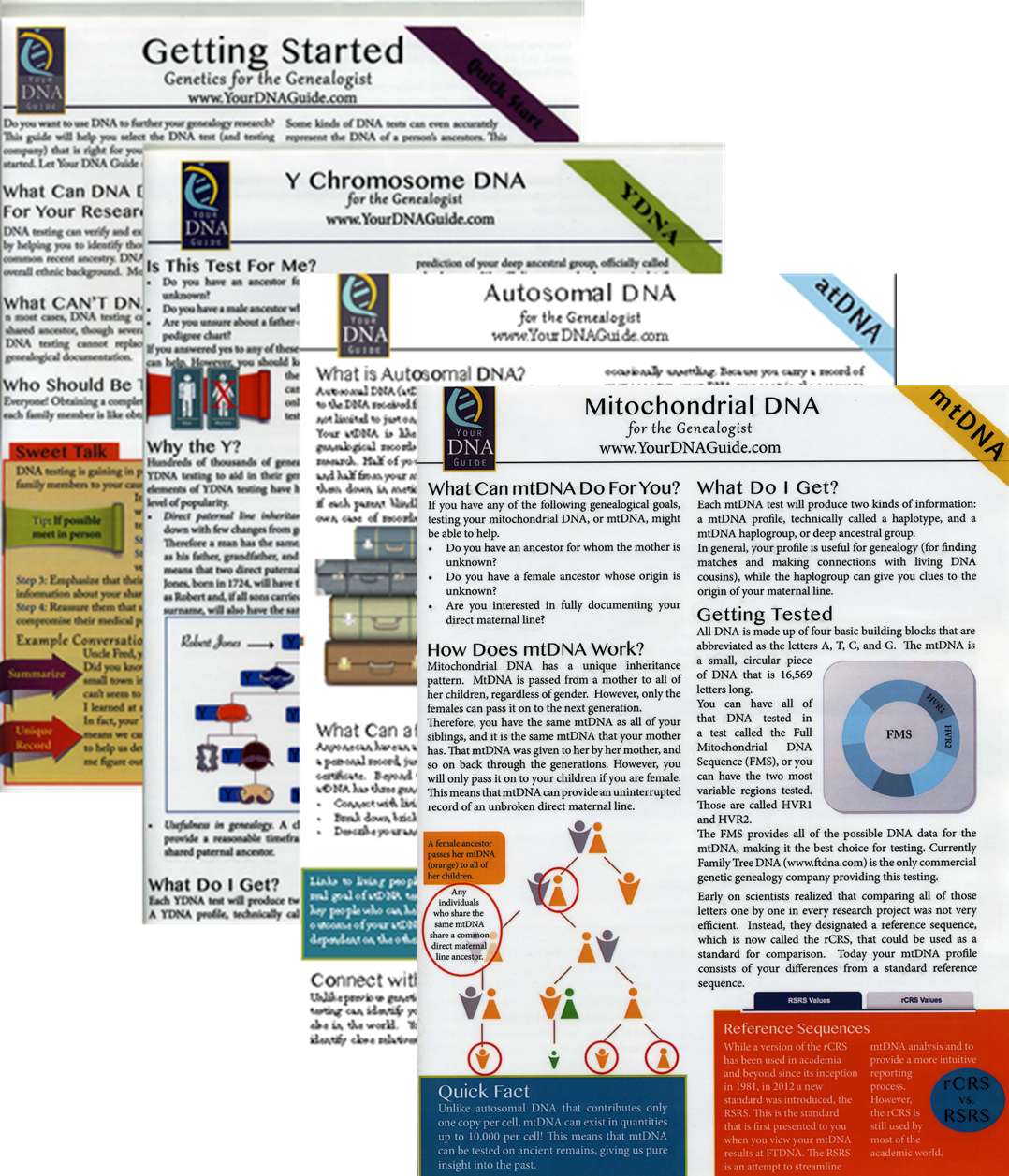 I can help you! Check out my series of quick guides (purchase all 4 laminated guides or the digital download bundle for the best deal):
I can help you! Check out my series of quick guides (purchase all 4 laminated guides or the digital download bundle for the best deal):



